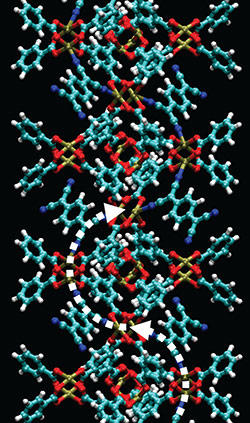
Electron-sharing TCNQ molecules bind to the copper ions in the framework to enable electrical conductivity in MOF materials. The dotted white arrows illustrate the mechanism of electrical conductivity in these materials. (TCNQ: 7,7,8,8-tetracyanoquinododimethane)
Scientists from the National Institute of Standards and Technology (NIST) and Sandia National Laboratories have added something new to a family of engineered, high-tech materials called metal-organic frameworks (MOFs): the ability to conduct electricity. This breakthrough—conductive MOFs—has the potential to make these already remarkable materials even more useful, particularly for detecting gases and toxic substances.
MOFs are three-dimensional crystalline materials with nanoscale pores made up of metal ions linked by various organic molecules. MOFs have huge surface areas, and scientists can easily control the size of their pores and how the pores interact with molecules by tinkering with their chemistries. These characteristics make them ideal for use as catalysts, membranes or sponges for gas storage or for drug delivery, among other applications.
Thousands of new MOF structures are discovered and characterized each year. While they come in a dizzying array of chemistries and structures, none of them conducts electricity well. The NIST/Sandia team developed a method to modify the electrical conductivity of MOF thin films and to control it over six orders of magnitude. Their findings will appear in the journal Science.
"MOFs are typically extremely poor electrical conductors because their constituent building blocks, the organic linkers and the metal ions, don't really talk to each other in terms of electrical conduction," says NIST materials engineer Andrea Centrone. "Our work points to a way of controlling and increasing their conductivity."
The group accomplished this by "infiltrating an insulating MOF with redox-active, conjugated guest molecules."
In other words, they infused and bound electron-sharing molecules into MOF thin films to create a material that is stable in air and approximately a million times more conductive than the unaltered MOF.
"Based on several spectroscopic experiments, we believe that the guest molecules serve two important purposes: they create additional bridges between the metal ions—copper, in this case—and they accept electrical charge," says NIST chemist Veronika Szalai.
According to NIST physicist Paul Haney, who provided some modeling for the experimental data, the arrangement of the guest molecules in the MOF creates a unique conductivity mechanism while preserving the benefits of the porous MOF crystalline structure.
These porous and conductive MOFs may be the first in an entirely new class of materials that could be used for sensing, conformal electronics (electronics that can bend and conform to unusual shapes), and other as-yet-unknown applications.
"Our discovery gives chemists and engineers a whole new degree of freedom to tailor these materials for their technological applications," says Centrone. "I would not be surprised if solar cells could be made using this new class of materials."
A.A. Talin, A. Centrone, A.C. Ford, M.E. Foster,V. Stavila, P. Haney, R.A. Kinney, V. Szalai, F. El Gabaly, H.P. Yoon, F. Léonard and M.D. Allendorf. Tunable electrical conductivity in metal-organic framework thin-film devices. Science Express. Posted online Dec. 5, 2013.

